Re-Animator Blu-ray Movie
HomeRe-Animator Blu-ray Movie 
Limited Edition | RemasteredArrow | 1985 | 1 Movie, 2 Cuts | 86 min | Not rated | Aug 08, 2017

Movie rating
7.8 | / 10 |
Blu-ray rating
| Users | 4.5 | |
| Reviewer | 4.5 | |
| Overall | 4.5 |
Overview
Re-Animator (1985)
Herbert West is obsessed with the idea of bringing the dead back to life. Experimenting with a glowing green fluid, he successfully reanimates dead tissue. Unfortunately, the dead are uncontrollable and difficult to subdue.
Starring: Jeffrey Combs, Bruce Abbott, Barbara Crampton, David Gale (I), Robert SampsonDirector: Stuart Gordon
| Horror | Uncertain |
| Dark humor | Uncertain |
| Sci-Fi | Uncertain |
| Comedy | Uncertain |
Specifications
Video
Video codec: MPEG-4 AVC
Video resolution: 1080p
Aspect ratio: 1.78:1
Original aspect ratio: 1.85:1
Audio
English: LPCM Mono (48kHz, 24-bit)
English: LPCM 2.0 (48kHz, 24-bit)
English: DTS-HD Master Audio 5.1 (48kHz, 16-bit)
English: DTS-HD Master Audio 5.1 (48kHz, 24-bit)
Music: DTS-HD Master Audio 5.1
Isolated Score (48kHz, 16-bit) only on Unrated / DTS-HD Master Audio 5.1 (48kHz, 24bit) only on Integral.
Subtitles
English SDH
Discs
Blu-ray Disc
Two-disc set (2 BDs)
Playback
Region free
Review
Rating summary
| Movie | 4.0 | |
| Video | 4.5 | |
| Audio | 4.0 | |
| Extras | 5.0 | |
| Overall | 4.5 |
Re-Animator Blu-ray Movie Review
Reviewed by Jeffrey Kauffman August 15, 2017Until the advent of Stephen King, Howard Phillips Lovecraft arguably had a more profound impact on American horror literature than any writer other than another three named author, Edgar Allan Poe. Lovecraft, who of course shortened his name to only include the initials of his first and middle names, also shared Poe’s at least occasional woes with finances, and one of the central ideas running through his works were fascinations with science and psychology, both of which informed Poe’s works, at least at times. One place where they differed markedly was with regard to their appearance, however. Poe was every bit the Romantic poet, looking a little mad eyed and more than a bit unkempt at times, while Lovecraft could probably easily have been mistaken for your reserved neighbor who made a living selling insurance policies. Despite the prevalence of supposed Poe inspired films that folks like Roger Corman brought out in droves in the sixties ( The Pit and the Pendulum, House of Usher ), some Poe fans might aver that the true spirit of Poe’s literary genius has never been adequately transferred to the screen. Lovecraft fans will almost be certain to add that their favorite author’s literary technique hasn’t been especially well served by film adaptations, though as I mentioned in our Bride of Re-Animator Blu-ray review, one film which translated its source material surprisingly well was Re-Animator, a film which has long been beloved by genre enthusiasts for its gonzo combo platter of extreme gore and pitch black humor, but which may owe as much of its enduring reputation to Lovecraft himself. Image Entertainment released a Blu-ray of the film several years ago, one which had controversial video quality (what else is new?), but which did at least offer quite a few supplements. Now Arrow, which released the handsome Bride of Re-Animator package linked to above, is offering fans new transfers of two versions of the first film, along with a copious amount of supplementary material.
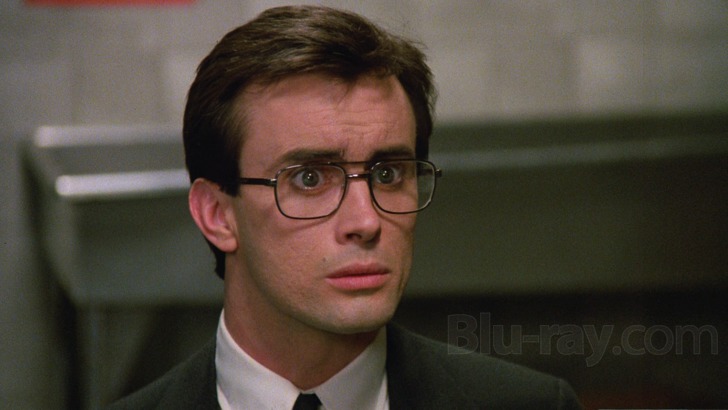
Since my hunch is most people coming to this review are more interested in a comparison of this release’s video and audio quality and supplementary material with that foregoing Image Entertainment release than with yet another rehashing of the film’s by now well known storyline, I’ll refrain from another plot summary. Those who aren’t acquainted with the film’s cheeky (and, frankly, other body parts) reimagining of the Frankenstein mythos will find an informative précis by Michael Reuben in the Re- Animator Blu-ray review of the Image Entertainment version.
Re-Animator Blu-ray Movie, Video Quality 
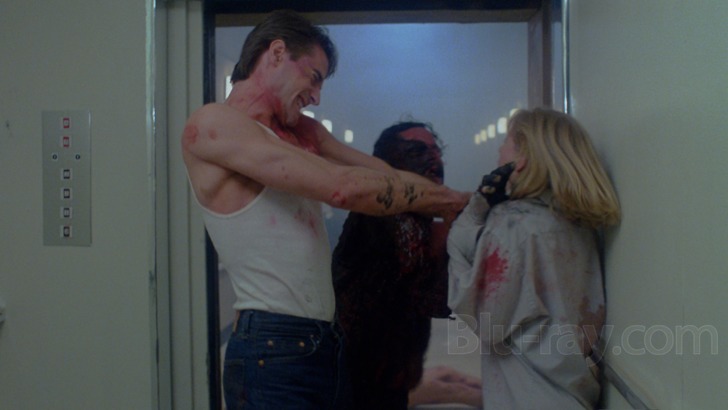
Re-Animator is presented on Blu-ray courtesy of Arrow Video with AVC encoded 1080p transfers in 1.78:1 of two versions of the film (on separate discs). The insert booklet (tucked inside a pocket inside the trifold digipak) contains quite a bit of information on both the differing versions as well as the transfers themselves:
On Restoring Re-AnimatorWhile I'm frankly a little curious about mention of both a negative and an IP in the above verbiage (I'm wondering if an IP was the source for the Integral Version), I have to say I really noticed no major discernable difference in the presentations of the shared footage between the two versions. While both versions still display the inherent softness that Michael Reuben mentioned in his Re-Animator Blu-ray review, these new transfers offer what to my eyes is a much better accounting of fine detail, making some of the gory special effects work even more memorable, and bringing new precision to more mundane elements like fabrics in costumes. The palette looks just slightly cooler than on the Image release, but things look "natural" (as much as a hyperbolic visual presentation like this can be termed that way), with all important reds looking especially vivid. The Arrow release also appears to be a tad darker than the Image to me, but, again, this presentation looked natural and organic, without any real deficits in shadow detail. Grain can still occasionally be on the chunky side (look at the top of the frame in screenshot 2 for an example), but generally resolves very well. Arrow has provided a viewing experience that's largely free of any major age related wear and tear (occasional minor flaws like the scratch in screenshot 7 can still be spotted, albeit very briefly), and with no problematic compression issues.
Brian Yuzna's Re-Animator was a textbook example of a work in progress. In total no less than three different versions of the film were initially released, with a fourth version released years later.
The Unrated Version
Brian Yuzna and director Stuart Gordon preferred their original cut of Re-Animator (1985) — what they eventually termed the Unrated Version — which ironically has the shortest running time. This version contains all scenes of gore and nudity intact and uncensored.
Practically at the same time, but without the involvement or consent of Yuzna and Gordon, an R-Rated Version was created on 35mm, which differed substantially from the Unrated Version. This version runs quite a bit longer (9 ˝ minutes) and in order to achieve an R-rating, many of the gore sequences were trimmed. The increased running time was made up mainly of dialogue scenes that were not used in the Unrated Version.
In addition, a more extensively censored TV Version was also created. The gore scenes were cut severely and replaced with additional alternative scenes rejected earlier by Yuzna and Gordon.
The Integral Version
Both the R-Rated and TV version had cut the film's gore sequences by various degrees and had extended the original cut's running time using alternative dialogue scenes.
It was years later that a new version appeared in Europe that contained nearly all of the gore scenes of the Unrated Version as well as the dialogue scenes unique to both the R-Rated and TV versions. More controversially however, this version had substantially reconstructed the story by placing these scenes in different parts of the film as well as using replacement dialogue in order to avoid duplication in the narrative. This version came to be known as the Integral Version.
Many were critical and dismissive of this new version. Neither Yuzna nore Gordon had given their consent to this new version and were not involved in its creation.
However, the passage of time has shown the Integral Version to become an accepted and valid version of Re-Animator, due to the new elements it contributes to the narrative and subtext of the film. Indeed, many have come to prefer this version of the film over the original Unrated Version. The gore elements from Yuzna and Gordon's original cut are intact, but certain plot lines and character studies are explored more fully, allowing for an arguably richer narrative experience. By contrast the original Unrated Version is very fast-paced and focuses squarely on the horror aspects of the story.
Restoration
Both the Unrated and Integral versions of Re-Animator were fully restored at TLEFilms FRPS, sources from the original film and audio elements. The original 35mm camera negative and interpositive elements were scanned in 5K sensor/4K resolution on the IMAGICA Imager XE Advanced Plus film scanner. The colour grading was completed on the Baselight using a 6-meter screen via 2K-native Christic DCI projector, a 10- bit OLED TV and CRT studio reference monitors.
Extensive digital restoration work was performed using Furnace, Combustion and PF Clean to repair issues such as dirt, scratches, torn or missing frames, and photochemical lab damage. The work was performed carefully to ensure no digital artefacts would be created.
The soundtracks to both versions were restored from the original 3-track master magnetic reels and alternative backup elements where necessary. Audio mixing and remastering was completed at TLEFilms FRPS. The multi-channel 5.1 mix was created by Tonmesiter Jochen Dorn.
Screenshots 1-9 are from the Unrated Version, and screenshots 10-18 are from the Integral Version. I've tried to recreate at least a few of the screenshots from Michael's review so that those wanting to do side by side comparisons are able to.
Re-Animator Blu-ray Movie, Audio Quality 
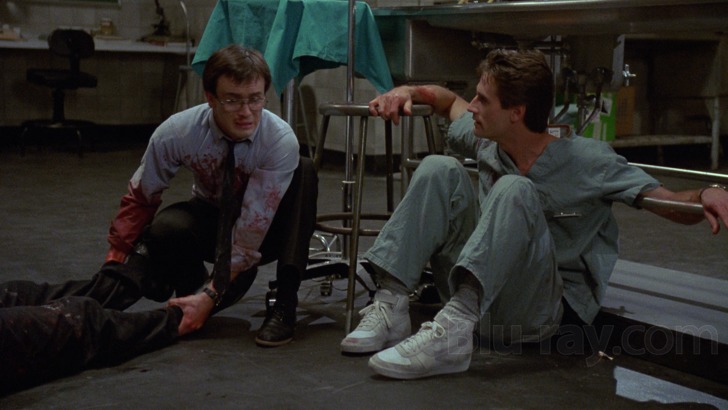
The Unrated Version of Re-Animator has three audio options, LPCM Mono, LPCM 2.0 and DTS-HD Master Audio 5.1. The Integral Version of Re-Animator features a DTS-HD Master Audio 5.1 track. Both surround tracks only engage the rear channels sporadically, at least in terms of discrete effect placement, though the film's score tends to reside a bit more regularly there, as well as in the side channels. That said, my hunch is few are going to find this a really consistently immersive surround track, and as such the mono and stereo options may be preferable (the film was evidently released in both mono and stereo in some markets, according to the IMDb). There's not a marked difference in fidelity or amplitude between these two tracks, though there is a nicer spread of effects and score in the 2.0 offering. Dialogue is consistently rendered cleanly (on all three choices, actually), and is typically well prioritized.
Re-Animator Blu-ray Movie, Special Features and Extras 
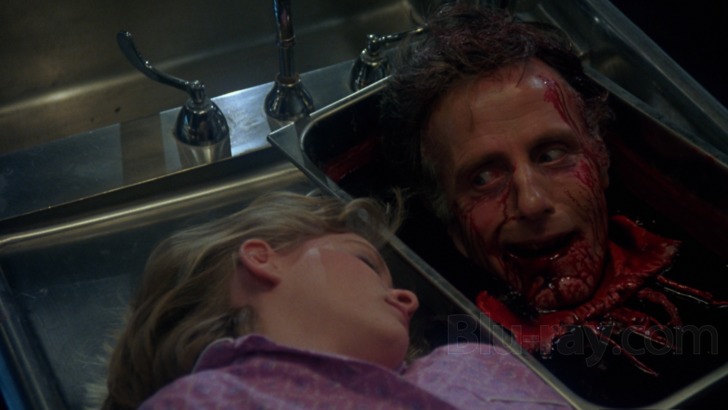
Arrow's release offers both new supplements and previously released supplements. I've marked all the new supplements with an asterisk (*).
Disc One
- Unrated Version (1080p; 1:26:06)
- Isolated Score* is presented in DTS-HD Master Audio 5.1.
- New Audio Commentary with Director Stuart Gordon and Actors Graham Skipper and Jesse Merlin of Re-Animator: The Musical *
- Audio Commentary with Stuart Gordon
- Audio Commentary with producer Brian Yuzna, actors Jeffrey Combs, Barbara Crampton, Bruce Abbott and Robert Sampson
- Re-Animator: Resurrectus (480i; 1:08:36) is a fantastically informative documentary on the making of the film, with some excellent interviews.
- Interviews
- Director Stuart Gordon and Producer Brian Yuzna (1080i; 48:47)
- Writer Dennis Paoli (1080i; 10:41)
- Composer Richard Band (1080i; 14:43)
- Fangoria Editor Tony Timpone (1080i; 4:34)
- Music Discussion (1080p; 16:31) features composer Richard Band.
- Barbara Crampton in Conversation* (1080p; 16:35) is a 2015 interview conducted by Alan Jones.
- The Catastrophe of Success: Stuart Gordon and the Organic Theater* (1080p; 13:08) is a fun look back at Gordon's stage origins.
- Theater of Blood — Re-Animator: The Musical* (1080p; 12:04) features lyricist Mark Nutter discussing adapting the property for the stage.
- Extended Scenes (1080p; 23:05)
- Deleted Scene (1080p; 2:40)
- Multi Angle Storyboards* allow toggling between storyboard and final version:
- Scene 1 (1080p; 00:48)
- Scene 2 (1080p; 2:51)
- Scene 3 (1080p; 1:20)
[Play around with your remote over in this neck of the woods for a surprise (1080i; 16:15)] - Trailer (1080p; 1:57)
- TV Spots (1080p; 2:36)
- Still Gallery* (1080p)
- Screenplay* is accessible via a BD-ROM drive.
- Integral Version (1080p; 1:44:56)
- A Guide to Lovecraftian Cinema* (1080p; 54:02) is a great overview of cinematic adaptations of the author's works, curated by Chris Lackey who hosts a Lovecraft oriented podcast. This comes with a spoiler warning, so forewarned is forearmed.
- Doug Bradley's Spinechillers: Herbert West - Reanimator* (1:38:32) is an audio supplement featuring Jeffrey Combs reading Lovecraft's original short story.
Re-Animator Blu-ray Movie, Overall Score and Recommendation 
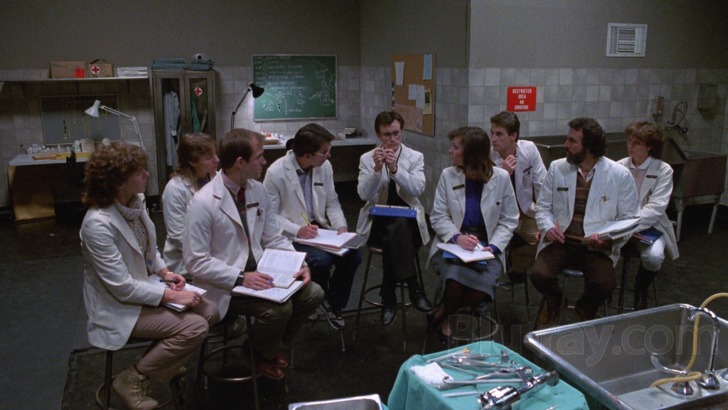
Re-Animator's already burnished (and bloody) reputation will probably only increase now with this very handsomely packaged set from Arrow. Both versions look better than ever, and Arrow has done its typically excellent job in providing a wealth of supplements and non-disc swag. Highly recommended.
Other editions
Re-Animator: Other Editions

Re-Animator
1985

Re-Animator
1985

Re-Animator
Limited Edition Artwork
1985

Re-Animator 4K
Ultimate Limited Edition Box Set
1985

Re-Animator 4K
Deluxe Edition Box Set
1985

Re-Animator
1985

Re-Animator 4K
1985
Similar titles
Similar titles you might also like

Bride of Re-Animator
1990

Night of the Creeps 4K
Collector's Edition
1986

The Return of the Living Dead 4K
1985

Basket Case 4K
Limited Edition
1982

Deathgasm
2015

Chopping Mall
Collector's Series
1986

Beyond Re-Animator
2003

Night of the Demons
Collector's Edition
1988

Puppet Master: The Littlest Reich
2018

The Funhouse
Collector's Edition
1981

Friday the 13th: Part 3
1982

Frankenhooker
1990

From Beyond 4K
Slipcover in Original Pressing
1986

Stitches
2012

The Blob 4K
1988

Dead Alive
Braindead | Unrated US Cut
1992

Hatchet
Unrated Director's Cut
2006

Night of the Comet
Collector's Edition
1984

Hatchet III
2013

The Stuff 4K
Limited Edition
1985